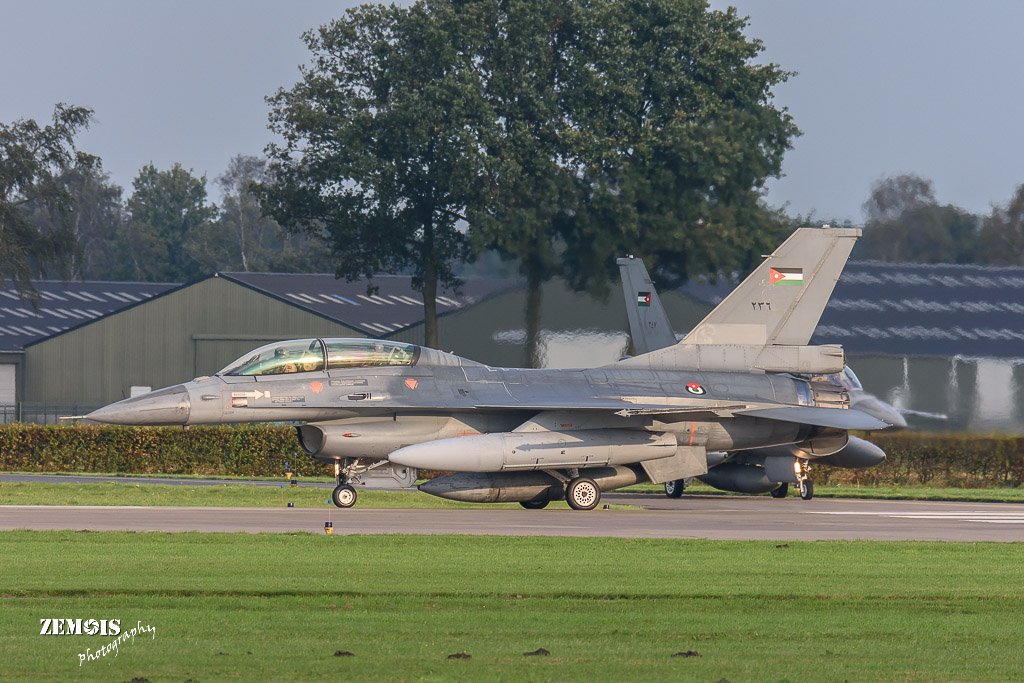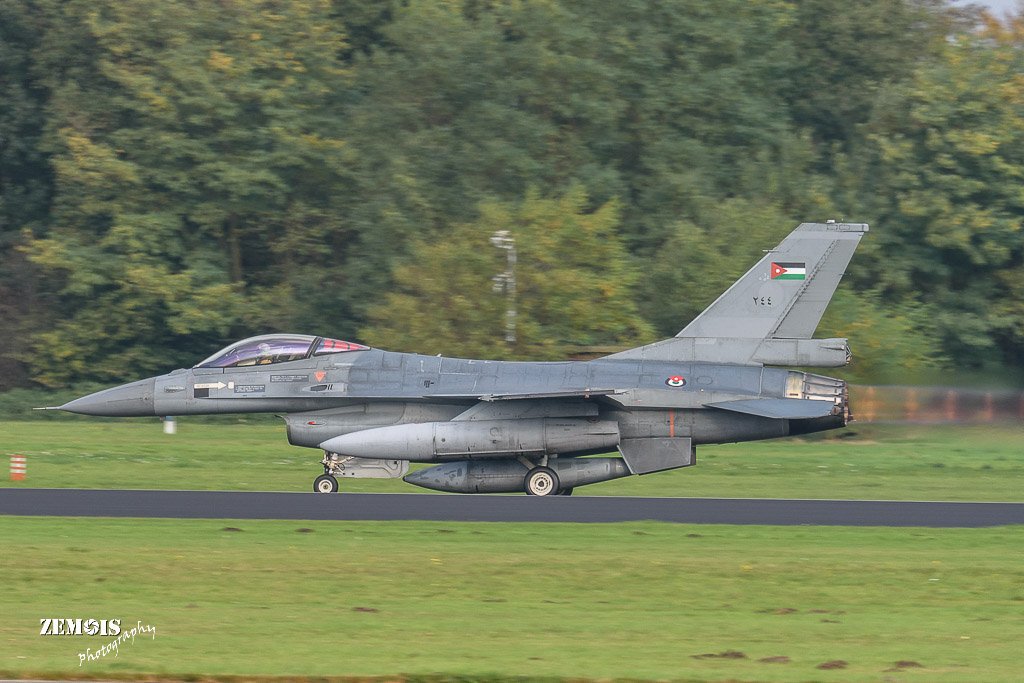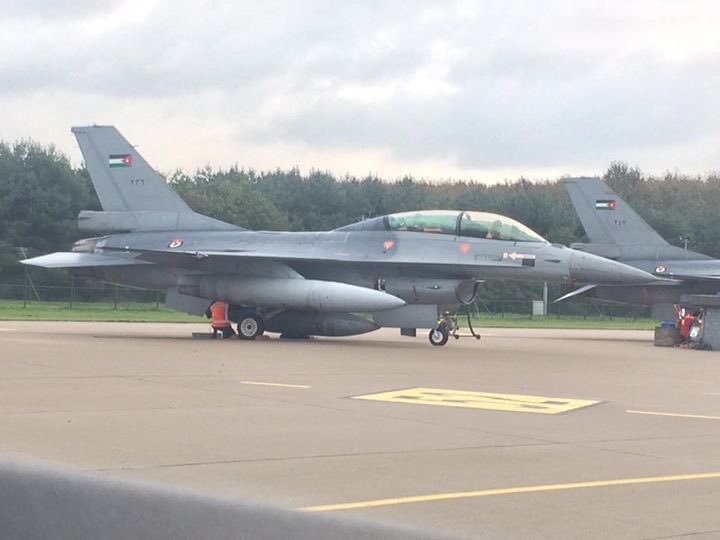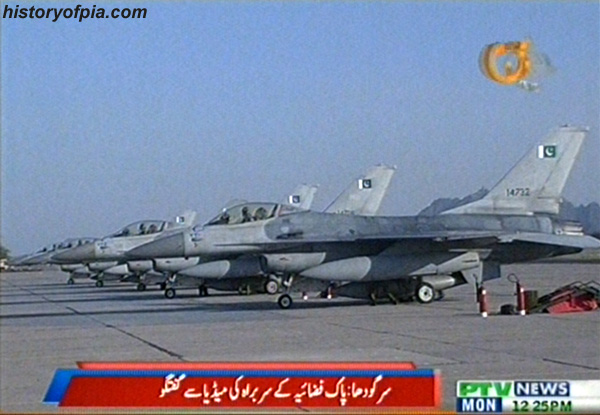F-16 MLU
Mid-Life Update
F-16 Versions main menu
History / The beginning
Reason for the Mid Life Update
When the F-16 entered service in 1979, it was expected that the aircraft would be replaced by a successor in 1999. Due to several reasons, both economical and political, the F-16 will not be replaced by a successor (which is not yet available right now) and will not be phased-out until 2010. In order to maintain the same level of operational capabilities and operational effectiveness of existing aircraft over the next ten to twenty years in this world of ever increasing technology, an extensive modernization program was developed, that later became known as the Mid-Life Update or
MLU.

The first
RDAF F-16B MLU, wearing the Check Six markings on its tail, on touchdown. (LMTAS photo)
The project started in 1989 with a two year study of the possibilities to upgrade the F-16. In May 1991, the development phase started, which continued until 1997.
Aircraft structural integrity program
The F-16s airframe has been subject to more heavy loads than was predicted in 1979. This resulted in several unpredicted hair cracks in some of the airframe's bulkheads. Before an aircraft can be offered for MLU modification, the current state of the airframe is examined in the extensive Aircraft Structural Integrity Program (PACER SLIP). In this modification program, all bulkheads of the aircraft will be examined and repaired (using the so called Cold Working method) if necessary. After PACER SLIP, the aircraft will be able to last at least another 5,000 flying hours and can complete its life expectancy of 30 years.
Note that hair cracks are not uncommon in aircraft design. To predict the acceptable number and type of cracks, the aircraft manufacturer used information that reflected the exact capabilities of the aircraft. The F-16 was designed as a light and highly maneuverable aircraft that could withstand 9G and last for a minimum of 8,000 flight hours. All data is recorded in a load spectrum that specifies the use of the aircraft (i.e. type of missions), aircraft load and predicted number of landings.
Participating countries
At first five countries participated in the Mid Life Update; the four EPAF (European Participating Forces) countries:
Belgium,
Denmark, the
Netherlands and
Norway, as well as the United States. Each of the countries has one Lead The Fleet (LTF) F-16 at the Lockheed-Martin plant in Fort Worth, Texas, as a trial aircraft for the modification. At the start of the program, it was projected that the USAF would also convert about 223 A/B-models under the MLU program. With the ending of the Cold War however, this part of the program was finished and the US backed-out after the development program.
In 2001,
Portugal announced that it too was considering upgrading its acquired with MLU. The Portuguese program started at the end of 2002, with the first aircraft (LTF) being delivered in early 2003. First 16 A-models and 4 B-models of the
Peace Atlantis II program will be upgraded. Followed later on by the other 20 F-16s.
In 2005,
Jordan was the following country to decide to upgrade their F-16s with the MLU package. Although their jets already had some upgrades since they were of the
ADF version, Jordan decided this wasn't sufficient to maintain in the long run. In a first phase all Peace Falcon II airframes (which hadn't flown awaiting the MLU upgrade) were to be upgraded with all Peace Falcon I airframes to be added later. The first jet was delvered back to the
RJAF in 2007.
In 2010
Pakistan also joined the MLU group. It decided to upgrade 35 of its older
block 15 airframes with an option for another 10. The first airframe to be converted was test flown in November of 2011 with initial work being performed by Lockheed, while the remainder of the fleet is to be upgraded by TAI in Ankara,
Turkey.
TVI aircraft for the MLU program
BAF F-16A Block 15R 80-3584 FA-93
RDAF F-16B
block 1 78-0204 ET-204
RNlAF F-16B Block 15B 80-3650 J-650
RNoAF F-16A Block 10B 78-0299 299
USAF F-16A Block 15A 80-0584 80584
LTF aircraft for the MLU program
BAF F-16B Block 15AA 87-0001 FB-21
RDAF F-16A
block 5 78-0177 E-177
RNLAF F-16A Block 10B 78-0251 J-251
RNoAF F-16B Block 10B 78-0306 306
PoAF F-16A Block 15P 82-1017 15133
RJAF F-16A Block 15A ADF 80-0589 671
PAF F-16B Block 15E 81-0933 82603
In total, 344 aircraft will be submitted to MLU (Portugal and possible future customers excluded):
Number of aircraft modified in the MLU program
BAF F-16A
block 10 - RNLAF F-16A Block 10 6
F-16B Block 10 - F-16B Block 10 4
F-16A Block 15 72 F-16A Block 15 107
F-16B Block 15 18 F-16B Block 15 20
RDAF F-16A Block 10 24 RNoAF F-16A Block 10 20
F-16B Block 10 5 F-16B Block 10 4
F-16A Block 15 24 F-16A Block 15 25
F-16B Block 15 8 F-16B Block 15 7
Each of the EPAF countries contribute to the MLU program :
- Belgium: SABCA Gosselies;
- Denmark: Depot at Aalborg;
- The Netherlands: Fokker Aircraft Services and the air force's DMVS depot at Woensdrecht;
- Norway: Depot at Kjeller.
Each aircraft will take up to 2,500 man hours, which is roughly equal to 5 months.
Initial work
All five Test, Verification and Installation (TVI) aircraft are stripped to the airframe and re-assembled in a later stadium in order to perform all kinds of work, including the replacement of hundreds of wiring harnesses (the cockpit alone incorporates one hundred new wiring harnesses).
When the aircraft will be completely re-assembled, they will be transported to Edwards Air Force Base in order to perform flight tests. After these flights, the Dutch and
Norwegian aircraft will moved to Leeuwarden Air Base for further flight tests. One of the tests include testing of the new fire control radar system under European weather conditions. In a later stadium, the Belgian TVI aircraft follows. At that time, the software tests will commence.
Is it worth all the effort and the money?
Because of the F-16s unpredicted heavier airframe load in the Royal Netherlands Air Force, the aircraft's airframe needs to be overhauled apart from the Mid Life Update to allow the airframe to complete 3,500 flight hours. Keeping the aircraft operational until its 5,000th flight hour make the costs involved in the airframe repair / overhaul affordable and acceptable, making expensive airframe "re-inspections" unnecessary. The costs of the airframe repair / overhaul only form a quarter of the costs involved in the Mid Life Update.
The costs involved in the ASIP maintenance program result in increased operational capabilities as well as an increased life expectancy for the F-16 aircraft. These costs are lower than the price of a new aircraft. After the F-16s Mid Life Update modernization program, the F-16 can compete again with the most advanced fighters of today's world. An increase of both technical and economical life expectancy justify the cost for the Mid Life Update program.
The air inlet structure of the Block 10 aircraft will be modified, due to the fact that the current inlet of Block 10 aircraft does not allow for the implementation of hard points to carry equipment such as the Forward Looking Infrared (FLIR) pod.
Structure & Avionics / Avionics upgrade
Most of the avionics that will be installed during MLU is existing hardware that is modified for use in the F-16. The Modular Mission Computer however is designed especially for the F-16. This will undoubtedly be one of the most important computers of the F-16 once MLU is completed.
Modular Mission Computer
The most important item of the Mid Life Update package is the Texas Instruments Modular Mission Computer (MMC) which is the key to providing new capabilities such as sensors and weapons, improved pilot-vehicle interface and pilot aiding. Subcontractors are Terma, Nea Lindberg and Signaal. This computer consists of line-replaceable modules (LRMs) based upon several MIPSCO R3000 32-bit RISC microprocessors which will run the ADA high-order language. An object-oriented design will reduce the lead times for new software and will improve the software maintenance. Other features include multiplex bus modules, avionics display processor, display driver and power supplies. The MMC will be the key to driving towards fleetwide commonality of system modes and software.
It will replace three components, namely the computers currently in use for the Expanded Fire Control Computer (XFCC), the Head Up Display Electronics Unit (HUD EU or HUD symbol generator), and the Stores Management System's Expanded Central Interface Unit (XCIU). The MMC will take up 42% less volume in the aircraft, weights 55% less and consumes 37% less electrical power. Of the 24 slots available in the computer, ten will be used for future growth.
Fire Control Radar
The Westinghouse AN/APG-66(V2) Fire Control Radar (FCR) will be equipped with an completely new signal data processor. It allows a track-while-scan mode for up to ten targets as well as a six-on-six
AIM-120 AMRAAM capability. Other features include a 25% improvement in detection and tracking range, an enhanced Doppler Beam Sharpening mode (DBS), enhanced air-ground and ground mapping modes, a medium resolutions DNS, an enhanced ECCM, and a color display compatibility. The MLU kit and the receiver will also have an 40% improved reliability over previous versions.
Physical parameters :
- Volume : 3.43 cu. ft.
- Weight : 261.5 lb
- Power : 3285 V/A AC (Max), 155 Watts DC (Nominal)
- Cooling : 11.3 lb/min a 27degr. C
Advanced IFF
The Hazeltine APX-111(V1) Advanced Identification Friend-or-Foe system (AIFF) with increased range performance (100 Nm) will operate via four (rather striking) antennas mounted on the upper forward fuselage in front of the canopy. These "bird slicers", more formally known as Upper Interogator Fuselage Mounted Antenna (FMA) Array, will be the most noticeable exterior change of the Mid Life Update.
The benefits of this AIFF system will be the support for BVR weapons delivery in excess of Radar/Missile limits and the enhanced situational awareness which reduces the chance of a fratricide.
Cockpit displays and indicators
Wide Angle Conventional Head Up display
The new Wide Angle Conventional Head Up Display (WAC HUD) manufactured by GEC Marconi Avionics will increase readability and pilot comfort, offers a wider field of view than the current HUD and adds a raster capability and support for night operations. This HUD is also FLIR and EEGS compatible.
Multi-Function Display
The Multi-Function Display (MFD) set, manufactured by Honeywell, include two 10cm x 10cm (4in x 4in) color active matrix liquid crystal multi-function displays, which will replace the current single monochrome Radar Electro/Optical Indicator Unit (REO-IU) and the Stores Control Panel (SCP) - the Stores Management System display. Both displays will increase the pilot's Situational Awareness drastically and will therefore contribute to increased flight safety.
Enhanced Upgraded Programmable Display Generator
An Enhanced Upgraded Programmable Display Generator (EUPDG), manufactured by Honeywell and Nea Lindberg in Denmark, will support the two color MFD's, allowing the pilot to set up to twelve display programs. One of them includes a color Horizontal Situation Display, which will be, provide the pilot with a God's eye view of the tactical situation. Inside is a 20MHz, 32-bit Intel 80960 Display Processor and a 256K battery-backed RAM system memory. The color graphics controller is based on the T.I. TMS34020 Raster Graphics Chipset.
Audio/Video Recorder
Also new is the Cockpit Television System manufactured by Telemetrics. The current Airborne Video Tape Recorder (AVTR) will be replaced by a TEAC color audio visual tape recorder. Head Up Display images as well as the images of the Multi Function Displays will be selectable for recording which is great for the debriefing of missions.

The same Danish MLU, now in flight. (LMTAS photo)
Helmet Mounted Display
A helmet-mounted display (HMD) is not part of the present configuration, but program director Philip Schwab believes that the European operators may decide to incorporate it if the program continues to progress well. Lockheed Martin and Honeywell have demonstrated the use of the HMD, combined with DTS, to allow the pilot to designate targets of opportunity simply by placing an HMD pipper on the target. EPAF and USAF are to pursue a five-nation HMD program, related to the introduction of the ASRAAM, the Advanced Short Range Air-to-Air Missile, somewhere in the next century. Software and hardware modifications are already being studied by a cockpit review team and both space and wiring is already being accounted for in the current MLU.
On Eglin AFB, Honeywell and GEC Marconi experiment with a Helmet Mounted Cueing System (HMCS), combined with Raytheon's Box-Office agile missile. Honeywell and GEC-Marconi will start with the development and promotion of a Look-And-Shoot Helmet Mounted Cueing System for the F-16. This year, flight tests will take place in one of Lockheed-Martin's F-16B duals.
Side stick controller and throttle grip
The side stick controller (manufactured by Lear Astronics Corporation) and throttle grip are
block 50 unit models and will replace the current Block-10/15 stick grips. Both throttle and stick will be equipped with various controls, for an increased variety of functions, including VHF and UHF communications, IFF interrogation, Improved Data Modem operation, secondary flight controls (speed brakes), night vision cockpit blackout selection (NVIS Switch) and boresighting as well as slaving of missiles (now only selectable via the cues of the Stores Control Panel, which requires hands-off-throttle, head-down operation).
Modifications & Upgrades / Other features
Improved Data Modem
The Improved Data Modem (IDM), developed by the U.S. Naval Research Laboratory and built by Symetrics Inc., will be used to exchange data of various systems and targets with other aircraft (e.g. F-16, A-10, AH-64 or E-8 JSTARS) or with a ground station. Provisions have been made for the Link 16 Joint Tactical Information Distribution System (JTIDS).
Electronic Warfare Management System
An Electronic Warfare Management System (EWMS) developed by Terma Elektronik AS in Denmark provides centralized EW control for entire EW suite : management of threats (RWR), ANQ pods and advanced chaff/flare systems.

Belgian Air Force
block 20 MLU. The block 20 can be distinguished by the birdslicers. These are part of the indiginous IFF system. (Luis Rosa photo)
Miniaturized Airborne GPS Receiver
MAGR, Miniaturized Airborne GPS Receiver built by Rockwell-Collins Avionics & Communications Division, operating via an E-Systems antenna. It provides accurate position, velocity and time to support navigation, steering and weapon delivery. This system is smaller and lighter than the Block 40/50 receiver (RCVR 3A), consumes less power but delivers the same performance.
Digital Terrain System
A Digital Terrain System (DTS), which uses the British Aerospace Systems & Equipments (BASE) Terprom system hosted on a Fairchild Defense memory module (128kb). The DTS provides precise navigation (in conjunction with the Rockwell/E-Systems GPS) and performs a number of safety and situational-awareness functions in low-level flight. This does not imply however, that the F-16 will be capable of automatic terrain following. The (former Block-10/-15) F-16 aircraft does not have a digital flight control system, so the system cannot be linked directly to the aircraft's Flight Control System. The pilot will be following the DTS advice manually by flying on the Flight Path Marker in the HUD. The system is as accurate as the accuracy of the maps being used, so this requires extremely accurate maps of the area.
Cockpit Layout
The cockpit layout will be the one of the F-16C Block-40/50. However, unlike the Block-40/50 aircraft, the MLU F-16s will be equipped with color displays. The cockpit lighing will be compatible with Night Vision Imaging System (NVIS) and all visible surfaces will be painted black. The Night Vision goggles are deactivated in the HUD field-of-view to allow inhibited HUD viewing.
Provisions for recce pods
Up to now, if the F-16 were to carry reconnaissance pods, it had to be specially equipped for that purpose. A number of Dutch F-16s has been equipped to carry the Oudedelft pod. The MLU will see a standard recce interface installed for a number of reconnaissance pods.
Provisions for the Microwave Landing System
This system will be incorporated in the F-16 structure. The system will not be standard equipment on the F-16 and the particular countries have to by it seperately. Although not standard, the system will enhance flight safety by adding an MLS, which can guide the pilot through adverse weather conditions.
Recent developments
First flights of TVI aircraft
The first of five TVI aircraft for the MLU has made its first flight from Fort Worth on April 28, 1995. This USAF F-16C,
#80-0584/ED, a Block 15 model, is destined for the 20 Fighter Wing at Shaw AFB. The second TVI aircraft made its first flight on May 11, 1995. This is a two-seat F-16B aircraft (
#ET-204) of the Royal Danish Air Force. The first two of five TVI aircraft were transported to Edwards AFB on June 9th, 1995.
Start of initial development test & evaluation
In June 1995, the first flights took place in the MLU's DT&E phase on Edwards Air Force base, under the leadership of main contractor Lockheed-Martin Tactical Aircraft Systems and the United States Air Force. Each of the four EPAF countries supplied its own test pilot.
Following the DT&E phase
Both aircraft will be equipped with special measurement systems and will be used in the Development Test & Evaluation test program at Edwards AFB, which will last until October 1997. The three other TVI aircraft will be used in the DT&E phase until mid-1996.
Further tests will then take place at Leeuwarden Air Base, The Netherlands, which will denote the start of the Operational Test & Evaluation phase of MLU. At Leeuwarden, four more MLU aircraft will join the program, the so called Lead The Fleet (LTF) aircraft, the first F-16s that will be modified for each of the four EPAF countries.
DT&E software tapes 1 thru 4
The DT&E aircraft now use the MLU Tape-1 software. This version will be replaced in June 1996 by the more extensive Tape-2 at the beginning of the OT&E phase. Tape-4 denote the final version which will be used in the Mid Life Update of other aircraft to be modified.
M1 tape
Development of the M1-tape went through four phases of Flight Test Tapes (FTT). In each of these test tapes, other performances where met, including:
FTT-1 tape
- Radar performance evaluation
FTT-2 tape
- Weapon modes Air-Air and Air-Ground testing
- Navigation (INS and GPS)
- Basic MMC core functions integration
FTT-3 tape
- Datalink
- IFF interrogation
- Horizontal Situation Display
- DTS integration
- Cockpit color screen implementation
FTT-4 tape
- "Clean-up" tape (intended as correction to imperfections found in earlier phases)
After the M1 tape, the M2 tape followed in 2000, M3 tape in 2003, M4 tape in 2005, M5 tape in 2008 and M6 tape in 2011. All these tapes incorporate other features, including:
M2 tape
- Automatic Target Hand-off System (ATHS)
- Integration of anti radiation (AGM-88) missile capability
- Integration of target designator system
- Further implementation of the Digital Terrain System
M3 tape
- Integration of the Link-16 system
- Integration of capability for GPS controlled weapons (GBU30/32)
- Introduction of Helmet Mounted/Cueing Sight
- Introduction of NVG compatible helmets
M4 tape
From this tape onwards the first release was already a subrelease starting at MX.1
M4.1 tape
- Introduction of advanced short-range missile, as a replacement for the current Sidewinder (AIM-9X, IRIS-T)
- Integration of advanced Link-16 functions
- Integration of SNIPER targeting pods
M4.2 tape
- Integration of the latest HARM Targeting System (HTS) and its R7 software
- Integration of SNIPER targeting pod and its S3 software (capable of cataloguing, storing and relaying target images using the Link 16 data-link. M4.2 gives the capability to use the HTS and Sniper ATP on the same aircraft)
This tape was the first common software for USAF CCIP upgraded block 40/50 airframes.
M4.3 tape
- "Clean-up" tape (intended as correction to imperfections found in earlier phases)
M5 tape
M5.1 tape
- Integration of capability for stand-off weapons (AGM-154)
- Introduction of more advanced A/G weapons (EGBU-12)
- Introduction of advanced Stores Management System and Joint Mission Planning System
- Introduction of an improved GPS/INS system (more accurate and jamming proof)
- Introduction of new Link-16 message standards to improve interoperability between different aircraft types
- Installation of AN/ARC-210 VHF radios to enable radio contact with FAC’s on the ground
M5.2 tape
- "Clean-up" tape (intended as correction to imperfections found in earlier phases)
M6 tape
M6.1 tape
- Improved IFF system (Mode 5 waveform with better distinction between friendly and enemy aircraft)
- Introduction of AIM-120D missile (two-way datalink, improved navigation and High-Angle Off-Boresight capabilities, a doubled range)
- Introduction of more advanced A/G weapons (GBU-39 SDB, GBU-54 LJDAM)
- Integration of improved Link-16 functions with net-centric capability
- Integration of a new Universal Armament Interface to standardize communication between the aircraft and the weapons, illuminating the need for new OPF tapes with every new weapon system
M6.2 tape
- "Clean-up" tape (intended as correction to imperfections found in earlier phases)
- Included minor updates like Auto GCAS capability nearly eliminating Controlled Flight Into Terrain (CFIT) accidents, a leading cause of F-16 loss of pilot and aircraft accidents.
M6.5 tape
From this tape onwards there will be a difference between the European numbering sequence and the US. Funding for the M-tapes was extended through the years up untill number M6. The normal succession would mean an M7 would be next. This will be the case for the US (with their F-16s lasting untill well into the 2030s). Since the European F-16s are much older and reaching the end of their lifespan (2020-2030) it was difficult to convince them to extend funding for more updates to the F-16s. Specifically the Netherlands and Norway weren't eager since they already opted to replace the F-16 with the F-35 with fleet introduction starting in 2019 and F-16 phase out around 2024). Much of the updates found in tape M6.5 will be the same as tape M7.
- Rectification of some earlier weapon integration shortcomings
- Integration of new weapons (JASSM, JDAM, EGBU-12, SDB, AIM-120D and AIM-9X)
- Integration of advanced racks (BRU-69), pylons, adapters and the UAI (ensuring nuclear surety and compatibility)
- Update of the Link-16 protocol
- Upgrade of the AN/AAQ-14 interface software
- Update of the AN/ALR-56M system
- Update of the GPS system
M7 tape
Will have the same set of updates as the European M6.5 tape. Most probably numbering will continue in the M7 and later tapes with the European air forces sticking in the M6.X numbering untill F-16 phase out is achieved in the 2020s.
Specifications
Engine: One Pratt & Whitney F100-PW-220 turbofan, rated at 14,590 lb.s.t. dry and 23,770 lb.s.t. with afterburning.
Maximum speed: Mach 2.05 at 40,000 feet. Service ceiling 55,000 feet. Maximum range 2400 miles. Initial climb rate 62,000 feet per minute.
Dimensions: wingspan 32 feet 9 1/2 inches, length 49 feet 3 1/2 inches, height 16 feet 8 1/2 inches, wing area 300 square feet.
Weights: 16,285 pounds empty, 25,281 pounds combat, 37,500 pounds maximum takeoff.














